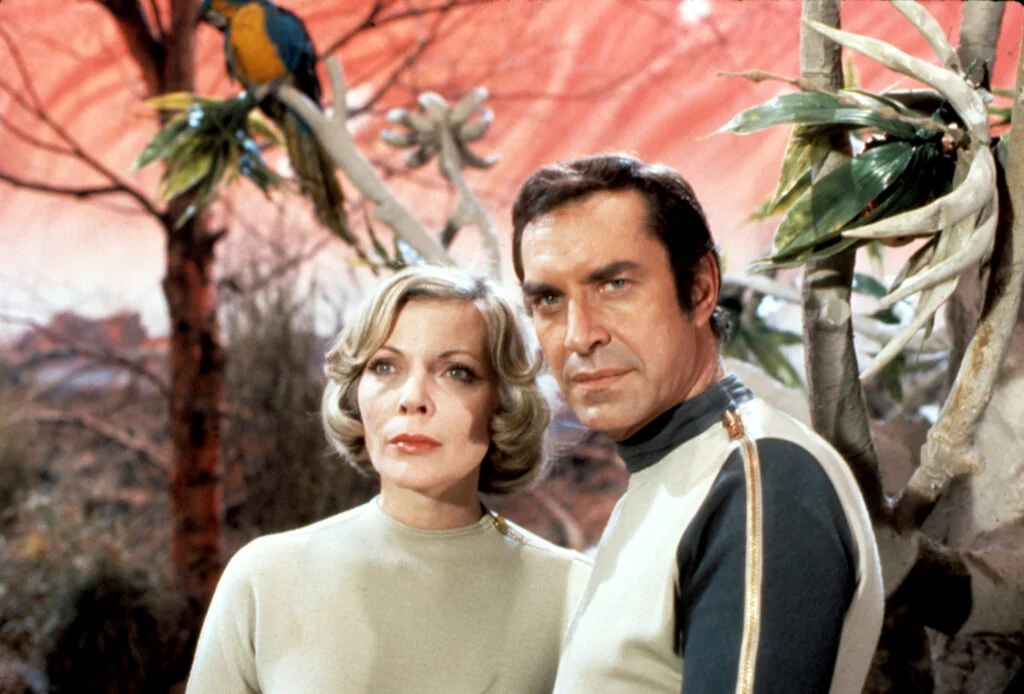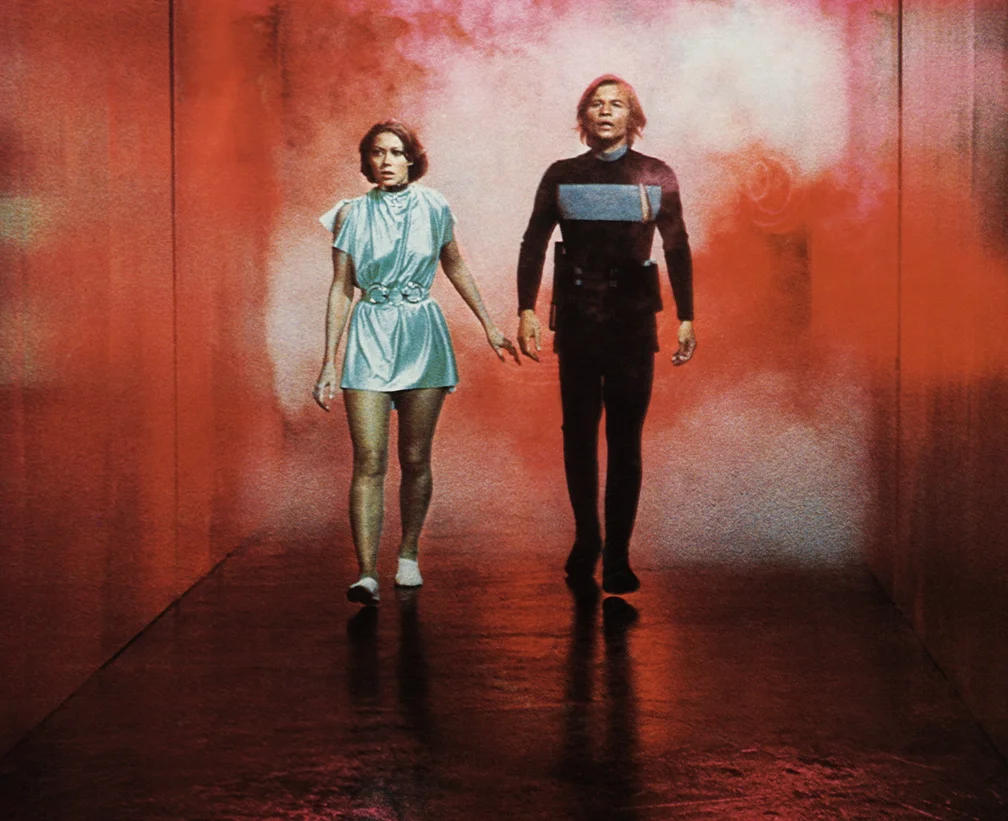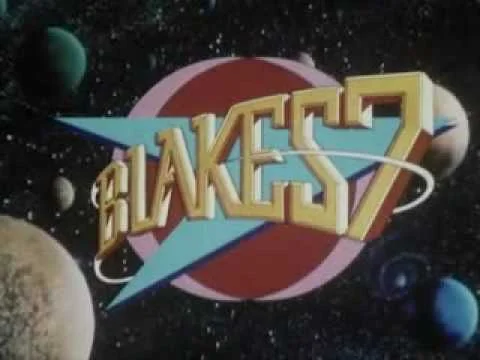Those grainy sci-fi shows of the ’60s and ’70s, with their cardboard sets and tinfoil costumes, often got more right about the future than wrong. While we laughed at their rubber-suited aliens and beep-boop computers, these visionary series were quietly forecasting technologies and social changes that we’re only now beginning to see unfold. Let’s take a look at some surprisingly accurate predictions from when bell-bottoms and sideburns ruled the airwaves.
1. Star Trek (1966-1969) – Handheld Communications and Universal Translators

When Captain Kirk flipped open his communicator, audiences chuckled at this pocket-sized fantasy device. Fast forward to today, and we’re all carrying smartphones that make Kirk’s communicator look primitive. The show also featured universal translators that instantly converted alien languages – technology we’re now developing with AI-powered real-time translation apps. Smithsonian Magazine credits the series with going so far as to influence real science, in addition to its massive impact on pop culture.
The Starship Enterprise’s computer responded to voice commands and accessed vast databases instantly. Sound familiar? We now talk to Alexa and Siri, asking them everything from weather reports to complex calculations. Those unrealistic touchscreen controls on the bridge? They’re now standard on everything from coffee makers to car dashboards.
2. Space: 1999 (1975-1977) – Wearable Computers and Smart Devices

This British series showed crew members wearing small computers on their wrists that monitored their vital signs and served as communication devices. Today, smartwatches and fitness trackers do exactly this, monitoring heart rates, sleep patterns, and stress levels while keeping us connected. Screen Rant untangles the way that the show has aged just fine and ways it definitely hasn’t.
The show also featured a computerized “Main Mission” control room where every surface was a screen. Modern command centers, from NASA to stock exchanges, now feature similar wall-to-wall displays. The idea that personal devices could control larger systems – standard practice today – was revolutionary in 1975.
3. The Six Million Dollar Man (1974-1978) – Advanced Prosthetics

Steve Austin’s bionic limbs seemed like pure fantasy in the ’70s. His enhanced strength and telescopic eye were the stuff of dreams. But today, we’re developing prosthetic limbs with neural interfaces that respond to thoughts, artificial eyes that restore partial vision, and exoskeletons that enhance human strength. According to Screen Rant, this franchise is getting the remake treatment in the very near future.
Modern prosthetics incorporate microprocessors that adapt to different terrains, just like Austin’s bionic legs. While we can’t yet run at 60 mph or lift cars, the gap between fiction and reality is narrowing as bioengineering advances. The show’s vision of human enhancement through technology is becoming more feasible every year.
4. UFO (1970-1971) – Space Defense Systems and Face Recognition

Gerry Anderson’s series depicted a secret organization protecting Earth from alien threats, using advanced tracking systems and facial recognition technology. Today, similar systems monitor our skies, while facial recognition has become commonplace in security and consumer applications.
The show’s moonbase and orbital defense platforms seemed outlandish then. Now, with plans for lunar bases and the militarization of space becoming reality, SHADO’s infrastructure doesn’t seem so far-fetched. Even their wearable identification badges prefigured today’s RFID security systems.
5. The Jetsons (1962-1963) – Smart Homes and Video Calls

While technically a cartoon, this vision of the 21st century accurately predicted many aspects of modern life. The Jetsons’ home was filled with voice-activated appliances, automated cleaning robots, and video communication – all commonplace today.
George Jetson worked a three-hour day from a home office (sound familiar, remote workers?), while his family enjoyed flat-screen TVs, drone delivery, and automated food preparation. The show even predicted online shopping and automatic pet feeders. The only thing missing is the flying cars.
6. The Time Tunnel (1966-1967) – Immersive Virtual Reality

This series featured scientists stepping into a tunnel that transported them through time, experiencing different eras with full sensory immersion. Today’s VR technology, while not allowing actual time travel, creates similarly immersive historical experiences, from walking through ancient Rome to witnessing key historical events.
The show’s massive control room, with its banks of computers and enormous screens, mirrors modern data centers and control facilities. Their concept of monitoring and interacting with field agents remotely is now standard practice in military and scientific operations.
7. The Tomorrow People (1973-1979) – Teleconferencing and Remote Medicine

Young mutants with telepathic abilities communicated instantly across distances – a concept that seemed supernatural then but is routine now with video conferencing. The show also depicted medical scans that could diagnose problems without invasive procedures, predicting modern MRI and CT technology.
Their “TIM” computer system provided real-time information access and acted as a virtual assistant – capabilities we now take for granted with Google and AI assistants. The idea that young people would lead technological adaptation also proved prescient.
8. Logan’s Run (1977-1978) – Automated Cities and Age Control Societies

The TV adaptation of the film showed a domed city run entirely by computers, with automated transport systems and AI-controlled infrastructure. Today, smart cities incorporate similar automated systems for traffic management, energy distribution, and public services.
While we don’t terminate people at 30, the show’s themes of youth obsession and age discrimination remain relevant. The series also depicted biometric identification and tracking, genetic manipulation, and holographic entertainment – all technologies currently in development or use.
9. Lost in Space (1965-1968) – Robotics and AI

The Robot in Lost in Space demonstrated artificial intelligence, emotional responses, and ethical decision-making. While it said “Danger, Will Robinson!” we’re now developing AI systems capable of recognizing and responding to human emotions, making ethical choices, and adapting to new situations.
The show also featured environmental domes for growing food in hostile conditions – technology now being developed for Mars colonization. Even the idea of a “space family” living off-world seems less fantastic as private companies plan permanent human settlements beyond Earth.
10. The Bionic Woman (1976-1978) – Enhanced Hearing and Cybernetic Integration

Jamie Sommers’ bionic ear could hear conversations miles away and detect specific frequencies. Today, hearing aids can filter out background noise, enhance speech, and connect to smartphones. Cochlear implants restore hearing through electronic stimulation of the auditory nerve.
The seamless integration of electronics with human biology, central to the show’s premise, is becoming reality with brain-computer interfaces and implantable devices. We’re even developing “smart tattoos” that monitor health metrics – not unlike Jamie’s hidden cybernetic components.
11. Battlestar Galactica (1978-1979) – AI Threat and Computer Viruses

The original series centered on humanity’s near-destruction by their own robotic creations. Today, discussions about AI safety and the potential risks of superintelligent systems dominate tech conferences. The show’s Cylons, while simplistic by today’s standards, raised questions about artificial consciousness that we’re still grappling with.
The concept of computer systems being vulnerable to attacks and viruses was speculative then but is now a daily reality. The show also depicted advanced propulsion systems and networked warfare – concepts now being explored in military technology.
12. Blake’s 7 (1978-1981) – Surveillance States and AI Ethics

This dystopian series portrayed a totalitarian government using omnipresent surveillance and AI-controlled systems to maintain power. Today’s debates about privacy, facial recognition, and government monitoring echo these themes with uncomfortable accuracy.
The show’s computer ORAC could access any database anywhere – presaging our interconnected internet. Meanwhile, the AI character ZEN demonstrated both the potential and limitations of artificial intelligence, raising ethical questions we’re only now seriously addressing. Even the show’s teleportation bracelets resemble today’s wearable tech.
These shows might have looked cheesy with their wobbly sets and polyester jumpsuits, but their creators saw further than most gave them credit for. They understood that the future isn’t just about gadgets – it’s about how those technologies change our society, our ethics, and our very humanity. As we edge closer to many of their predictions, it’s worth remembering that sometimes the best guide to tomorrow comes wrapped in the entertainment of yesterday.


